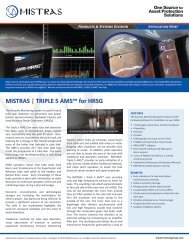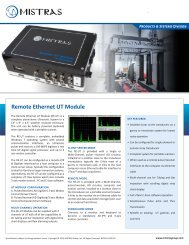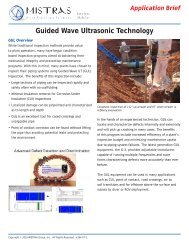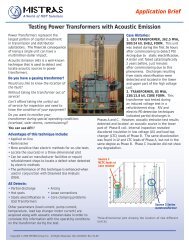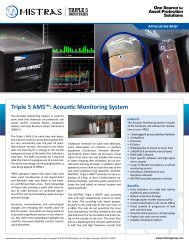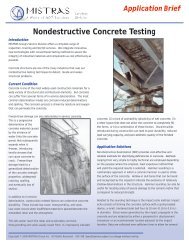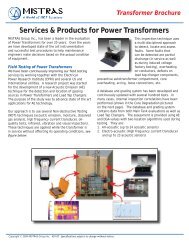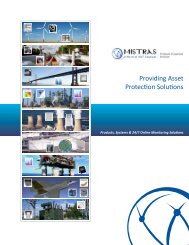ANDT Oil and Gas Brochure - MISTRAS Group, Inc.
ANDT Oil and Gas Brochure - MISTRAS Group, Inc.
ANDT Oil and Gas Brochure - MISTRAS Group, Inc.
You also want an ePaper? Increase the reach of your titles
YUMPU automatically turns print PDFs into web optimized ePapers that Google loves.
HEAT EXCHANGERS & CONDENSERS<br />
A variety of tube inspection techniques are used<br />
for bundle inspections. The choice of technique<br />
depends on the tube material type. <strong>MISTRAS</strong><br />
technicians are cross trained on IRIS, Remote Field<br />
Eddy Current, Near Field Eddy Current <strong>and</strong> st<strong>and</strong>ard<br />
Eddy Current techniques <strong>and</strong> use the same<br />
operating system to achieve these results. This<br />
“Cross Training” allows us to minimize the amount<br />
of technicians we need to deploy to your project,<br />
ultimately saving inspection dollars.<br />
Heat Exchangers <strong>and</strong> Condensers are subject to<br />
various issues related to the tube bundles such as:<br />
• Internal <strong>and</strong> External Pitting <strong>and</strong><br />
Corrosion <strong>and</strong> Erosion<br />
• Cracking (SCC, Fatigue, Thermal, Vibration)<br />
• Mechanical damage (Inlet Erosion,<br />
Baffle Fretting, Freeze Bulges, Tool Gouges)<br />
A variety of advanced techniques are used for<br />
bundle inspections, such as:<br />
REMOTE FIELD TESTING (RFT)<br />
Carbon steel tube bundles are inspected using<br />
RFT. The RFT technique utilizes the same platform<br />
as our st<strong>and</strong>ard ET inspections which does not<br />
require tubes to be as clean as other techniques.<br />
Our professional inspectors are cross trained to<br />
provide both ET <strong>and</strong> RFT while on site.<br />
www.mistrasgroup.com | +1.609.716.4150 | sales@mistrasgroup.com<br />
NFT Sample Damage 3D Reporting<br />
NEAR FIELD TESTING (NFT)<br />
NFT is used for inspecting fin fan (air coolers)<br />
designed tube bundles. Also available in our<br />
st<strong>and</strong>ard ET equipment platform, NFT is a very<br />
reliable technique to determine ID anomalies -<br />
such as inlet erosion, corrosion, <strong>and</strong> pitting - that<br />
normally occur during service in this previously<br />
difficult to inspect tube design.<br />
INTERNAL ROTARY INSPECTION SYSTEM (IRIS)<br />
IRIS uses ultrasonic technology with a rotating<br />
transducer to deliver quantifiable data on the ID<br />
or OD damage to tubes. Primarily used as a prove<br />
up tool, IRIS requires tubes to be cleaner than other<br />
tube inspection techniques <strong>and</strong> scan speeds to<br />
be slightly slower. Also available in our ET equipment<br />
platform, all IRIS tube data is presented in a<br />
C-Scan <strong>and</strong> B-Scan profile & archived for playback.<br />
EDDY CURRENT (ET)<br />
ET is the predominant inspection technique for the<br />
alloy tubes. ET does not require the tubes to be<br />
as clean as some other techniques <strong>and</strong> is relatively<br />
fast compared to more quantitative techniques<br />
like IRIS. <strong>MISTRAS</strong>’ tube inspection specialists<br />
utilize the latest ET technology along with an<br />
electronic reporting format that allows for quick<br />
analysis <strong>and</strong> generation of tube sheet drawings<br />
<strong>and</strong> results in an easy to read template.<br />
3-D REPORTING<br />
<strong>MISTRAS</strong> tube inspection reports are revolutionary<br />
in their ability to provide defect data down the<br />
length of the tube. The tube data allows owners<br />
the increased ability to determine the root cause<br />
of tube degradation <strong>and</strong> potentially allows them<br />
to avoid the problem in the future through operating<br />
procedural changes or change in tube material<br />
choice during bundle repair. All tube inspection<br />
data is left on site in order to speed the process of<br />
getting the exchanger into production as quickly<br />
as possible. Tube inspection specialists review all<br />
on-site data & provide the final report to the client<br />
within 72 hours of the completion of the project.<br />
4



